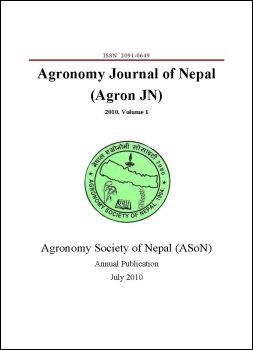Emergence of improved varieties of maize (Zea mays L.) as affected by different soil types and planting depths in Chitwan, Nepal
DOI:
https://doi.org/10.3126/ajn.v1i0.7539Keywords:
Emergence, soil types, planting depths, improved varietiesAbstract
Improved open pollinated maize (Zea mays L.) varieties exhibit different emergence reaction as a result of either inferior seed quality or affected by agronomic practices of maize planting. To address problem of low emergence percentage of maize varieties, an experiment was laid out in factorial design under two types of soil (red clay and sandy loam), three level of depth of sowing (7, 14 and 21 cm) for Rampur Composite, Manakamana-1 and Arun-2 maize varieties in Rampur, Chitwan for representing main season (May-August). The result of the experiment revealed that emergence count was highly significant for soil types and depth of sowing among the maize varieties tested. Manakamana-1 expressed lowest percentage (20 and 29%) followed by Arun-2 (22 and 33%) and Rampur Composite (24 and 39%) of emergence under red clay and sandy loam soils, respectively. Likewise, emergence count at 10 days after sowing was recorded highly significant for depth of showing indicating that irrespective of varieties higher the planting depth lower the emergence count.. There was a positive relation between depth of planting and length of mesocotyle resulting loss of seed vigor which furnished low emergence of the maize varieties. It is suggested that depth of sowing affect emergence percentage which consequently have effects on plant population maintenance. Hence, it was concluded that sowing below 7cm deep is not feasible for the tested varieties under red clay and sandy loam soils.
DOI: http://dx.doi.org/10.3126/ajn.v1i0.7539
Agronomy Journal of Nepal (Agron JN) Vol. 1: 2010 pp.23-27
Downloads
Downloads
Published
How to Cite
Issue
Section
License
ASON permits for free use, distribution and reproduction in any medium if the original work is properly cited and not used for commercial purposes.




